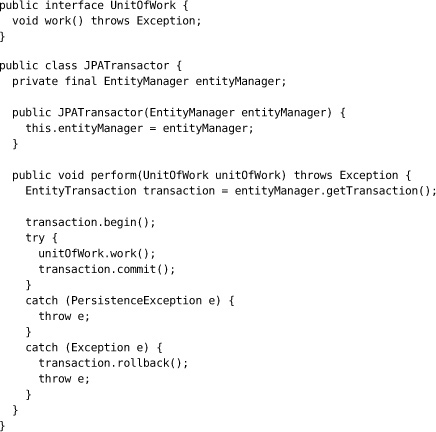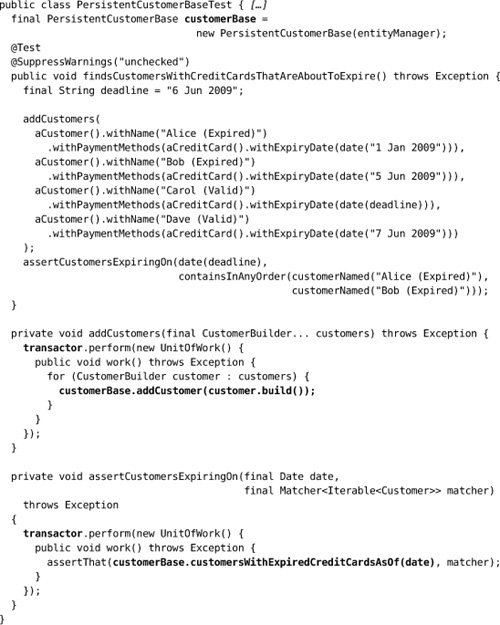Chapter 25. Testing Persistence
It is always during a passing state of mind that we make lasting resolutions.
—Marcel Proust
Introduction
As we saw in Chapter 8, when we define an abstraction in terms of a third-party API, we have to test that our abstraction behaves as we expect when integrated with that API, but cannot use our tests to get feedback about its design.
A common example is an abstraction implemented using a persistence mechanism, such as Object/Relational Mapping (ORM). ORM hides a lot of sophisticated functionality behind a simple API. When we build an abstraction upon an ORM, we need to test that our implementation sends correct queries, has correctly configured the mappings between our objects and the relational schema, uses a dialect of SQL that is compatible with the database, performs updates and deletes that are compatible with the integrity constraints of the database, interacts correctly with the transaction manager, releases external resources in a timely manner, does not trip over any bugs in the database driver, and much more.
When testing persistence code, we also have more to worry about with respect to the quality of our tests. There are components running in the background that the test must set up correctly. Those components have persistent state that could make tests interfere with each other. Our test code has to deal with all this extra complexity. We need to spend additional effort to ensure that our tests remain readable and to generate reasonable diagnostics that pinpoint why tests fail—to tell us in which component the failure occurred and why.
This chapter describes some techniques for dealing with this complexity. The example code uses the standard Java Persistence API (JPA), but the techniques will work just as well with other persistence mechanisms, such as Java Data Objects (JDO), open source ORM technologies like Hibernate, or even when dumping objects to files using a data-mapping mechanism such as XStream1 or the standard Java API for XML Binding (JAXB).2
1. http://xstream.codehaus.org
2. Apologies for all the acronyms. The Java standardization process does not require standards to have memorable names.
An Example Scenario
The examples in this chapter will all use the same scenario. We now have a web service that performs auction sniping on behalf of our customers.
A customer can log in to different auction sites and has one or more payment methods by which they pay for our service and the lots they bid for. The system supports two payment methods: credit cards and an online payment service called PayMate. A customer has a contact address and, if they have a credit card, the card has a billing address.
This domain model is represented in our system by the persistent entities shown in Figure 25.1 (which only includes the fields that show what the purpose of the entity is.)
Figure 25.1 Persistent entities
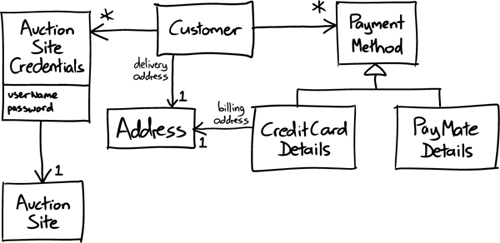
Isolate Tests That Affect Persistent State
Since persistent data hangs around from one test to the next, we have to take extra care to ensure that persistence tests are isolated from one another. JUnit cannot do this for us, so the test fixture must ensure that the test starts with its persistent resources in a known state.
For database code, this means deleting rows from the database tables before the test starts. The process of cleaning the database depends on the database’s integrity constraints. It might only be possible to clear tables in a strict order. Furthermore, if some tables have foreign key constraints between them that cascade deletes, cleaning one table will automatically clean others.
The order in which tables must be cleaned up should be captured in one place because it must be kept up-to-date as the database schema evolves. It’s an ideal candidate to be extracted into a subordinate object to be used by any test that uses the database:
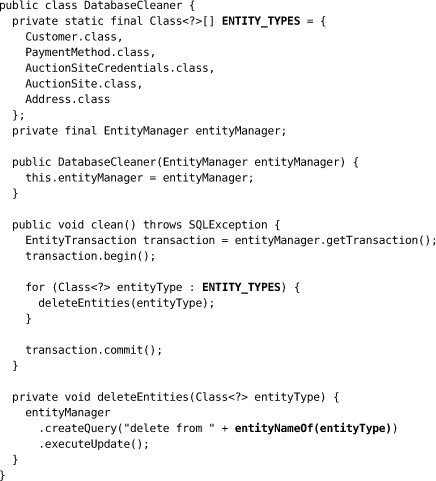
We use an array, ENTITY_TYPES, to ensure that the entity types (and, therefore, database tables) are cleaned in an order that does not violate referential integrity when rows are deleted from the database.3 We add DatabaseCleaner to a setup method, to initialize the database before each test. For example:
3. We’ve left entityNameOf() out of this code excerpt. The JPA says the the name of an entity is derived from its related Java class but doesn’t provide a standard API to do so. We implemented just enough of this mapping to allow DatabaseCleaner to work.

For brevity, we won’t show this cleanup in the test examples. You should assume that every persistence test starts with the database in a known, clean state.
Make Tests Transaction Boundaries Explicit
A common technique to isolate tests that use a transactional resource (such as a database) is to run each test in a transaction which is then rolled back at the end of the test. The idea is to leave the persistent state the same after the test as before.
The problem with this technique is that it doesn’t test what happens on commit, which is a significant event. The ORM flushes the state of the objects it is managing in memory to the database. The database, in turn, checks its integrity constraints. A test that never commits does not fully exercise how the code under test interacts with the database. Neither can it test interactions between distinct transactions. Another disadvantage of rolling back is that the test discards data that might be useful for diagnosing failures.
Tests should explicitly delineate transactions. We also prefer to make transaction boundaries stand out, so they’re easy to see when reading the test. We usually extract transaction management into a subordinate object, called a transactor, that runs a unit of work within a transaction. In this case, the transactor will coordinate JPA transactions, so we call it a JPATransactor.4
4. In other systems, tests might also use a JMSTransactor for coordinating transactions in a Java Messaging Service (JMS) broker, or a JTATransactor for coordinating distributed transactions via the standard Java Transaction API (JTA).
The transactor is called by passing in a UnitOfWork, usually created as an anonymous class:

This pattern is so useful that we regularly use it in our production code as well. We’ll show more of how the transactor is used in the next section.
Testing an Object That Performs Persistence Operations
Now that we’ve got some test scaffolding we can write tests for an object that performs persistence.
In our domain model, a customer base represents all the customers we know about. We can add customers to our customer base and find customers that match certain criteria. For example, we need to find customers with credit cards that are about to expire so that we can send them a reminder to update their payment details.

When unit-testing code that calls a CustomerBase to find and notify the relevant customers, we can mock the interface. In a deployed system, however, this code will call a real implementation of CustomerBase that is backed by JPA to save and load customer information from a database. We must also test that this persistent implementation works correctly—that the queries it makes and the object/relational mappings are correct. For example, below is a test of the customersWithExpiredCreditCardsAt() query. There are two helper methods that interact with customerBase within a transaction: addCustomer() adds a set of example customers, and assertCustomersExpiringOn() queries for customers with expired cards.
We call addCustomers() with CustomerBuilders set up to include a name and an expiry date for the credit card. The expiry date is the significant field for this test, so we create customers with expiry dates before, on, and after the deadline to demonstrate the boundary condition. We also set the name of each customer to identify the instances in a failure (notice that the names self-describe the relevant status of each customer). An alternative to matching on name would have been to use each object’s persistence identifier, which is assigned by JPA. That would have been more complex to work with (it’s not exposed as a property on Customer), and would not be self-describing.
The assertCustomersExpiringOn() method runs the query we’re testing for the given deadline and checks that the result conforms to the Hamcrest matcher we pass in. The containsInAnyOrder() method returns a matcher that checks that there’s a sub-matcher for each of the elements in a collection. We’ve written a customerNamed() method to return a custom matcher that tests whether an object is a Customer with a given name (there’s more on custom matchers in Appendix B). So, this test says that we expect to receive back exactly two Customer objects, named "Alice (Expired)" and "Bob (Expired)".
The test implicitly exercises CustomerBase.addCustomer() by calling it to set up the database for the query. Thinking further, what we actually care about is the relationship between the result of calling addCustomer() and subsequent queries, so we probably won’t test addCustomer() independently. If there’s an effect of addCustomer() that is not visible through some feature of the system, then we’d have to ask some hard questions about its purpose before writing a special test query to cover it.
Here is an implementation of PersistentCustomerBase that passes the test:
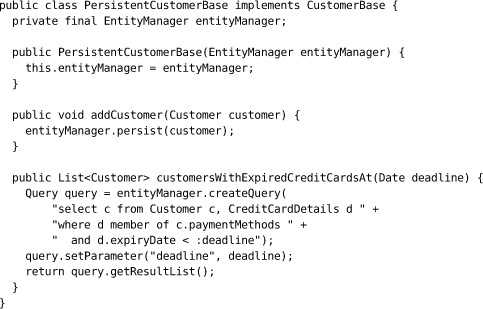
This implementation looks trivial—it’s so much shorter than its test—but it relies on a lot of XML configuration that we haven’t included and on a third-party framework that implements the EntityManager’s simple API.
Testing That Objects Can Be Persisted
The PersistentCustomerBase relies on so much configuration and underlying third-party code that the error messages from its test can be difficult to diagnose. A test failure could be caused by a defect in a query, the mapping of the Customer class, the mapping of any of the classes that it uses, the configuration of the ORM, invalid database connection parameters, or a misconfiguration of the database itself.
We can write more tests to help us pinpoint the cause of a persistence failure when it occurs. A useful test is to “round-trip” instances of all persistent entity types through the database to check that the mappings are configured correctly for each class.
Round-trip tests are useful whenever we reflectively translate objects to and from other forms. Many serialization and mapping technologies have the same advantages and difficulties as ORM. The mapping can be defined by compact, declarative code or configuration, but misconfiguration creates defects that are difficult to diagnose. We use round-trip tests so we can quickly identify the cause of such defects.
Round-Tripping Persistent Objects
We can use a list of “test data builders” (page 257) to represent the persistent entity types. This makes it easy for the test to instantiate each instance. We can also use builder types more than once, with differing set-ups, to create entities for round-tripping in different states or with different relationships to other entities.
This test loops through a list of builders (we’ll show how we create the list in a moment). For each builder, it creates and persists an entity in one transaction, and retrieves and compares the result in another. As in the last test, we have two transactor methods that perform transactions. The setup method is persistedObjectFrom() and the query method is assertReloadsWithSameStateAs().
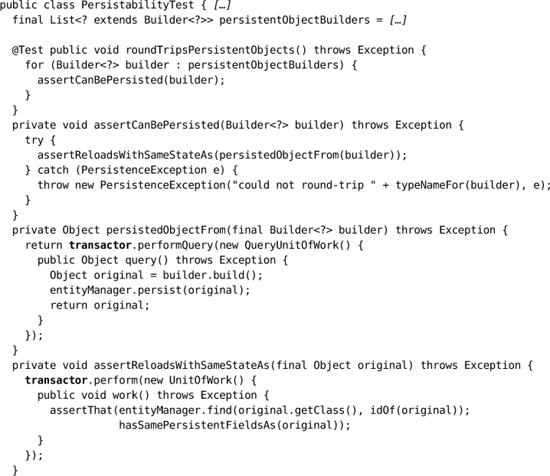
The persistedObjectFrom() method asks its given builder to create an entity instance which it persists within a transaction. Then it returns the new instance to the test, for later comparison; QueryUnitOfWork is a variant of UnitOfWork that allows us to return a value from a transaction.
The assertReloadsWithSameStateAs() method extracts the persistence identifier that the EntityManager assigned to the expected object (using reflection), and uses that identifier to ask the EntityManager to retrieve another copy of the entity from the database. Then it calls a custom matcher that uses reflection to check that the two copies of the entity have the same values in their persistent fields.
Round-Tripping Related Entities
Creating a list of builders is complicated when there are relationships between entities, and saving of one entity is not cascaded to its related entities. This is the case when an entity refers to reference data that is never created during a transaction.
For example, our system knows about a limited number of auction sites. Customers have AuctionSiteCredentials that refer to those sites. When the system creates a Customer entity, it associates it with existing AuctionSites that it loads from the database. Saving the Customer will save its AuctionSiteCredentials, but won’t save the referenced AuctionSites because they should already exist in the database. At the same time, we must associate a new AuctionSiteCredentials with an AuctionSite that is already in the database, or we will violate referential integrity constraints when we save.
The fix is to make sure that there’s a persisted AuctionSite before we save a new AuctionSiteCredentials. The AuctionSiteCredentialsBuilder delegates to another builder to create the AuctionSite for the AuctionSiteCredentials under construction (see “Combining Builders” on page 261). We ensure referential integrity by wrapping the AuctionSite builder in a Decorator [Gamma94] that persists the AuctionSite before it is associated with the AuctionSiteCredentials. This is why we call the entity builder within a transaction—some of the related builders will perform database operations that require an active transaction.

But Database Tests Are S-l-o-w!
Tests that run against realistic infrastructure are much slower than unit tests that run everything in memory. We can unit-test our code by defining a clean interface to the persistence infrastructure (defined in terms of our code’s domain) and using a mock persistence implementation—as we described in “Only Mock Types That You Own” (page 69). We then test the implementation of this interface with fine-grained integration tests so we don’t have to bring up the entire system to test the technical layers.
This lets us organize our tests into a chain of phases: unit tests that run very quickly in memory; slower integration tests that reach outside the process, usually through third-party APIs, and that depend on the configuration of external services such as databases and messaging brokers; and, finally, end-to-end tests that run against a system packaged and deployed into a production-like environment. This gives us rapid feedback if we break the application’s core logic, and incremental feedback about integration at increasingly coarse levels of granularity.

